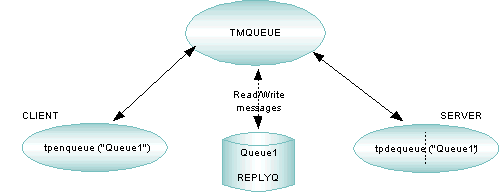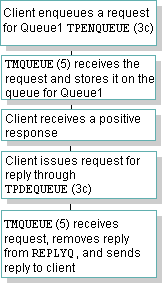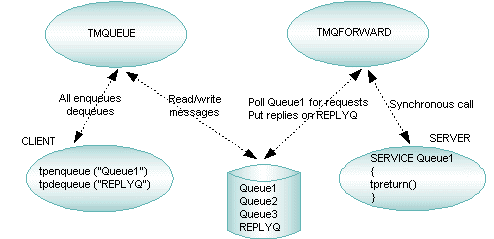


|

|
|
|
|
Storing Messages and Service Requests: Using BEA Tuxedo /Q
The BEA Tuxedo /Q extension allows clients and servers to store messages or service requests for guaranteed processing. The system guarantees requests are sent through the transaction protocol to ensure safe storage. The administrative functions of BEA Tuxedo /Q provide the administrator with a great deal of flexibility in establishing and managing queues, and configuring system servers provided with the queued message facility.
Using the Message Queuing Server
A message queuing server (TMQUEUE) allows for transparent enqueueing and dequeueing of messages. The following illustration shows how TMQUEUE works.
Queueing Messages Using TMQUEUE

qmadmin(1) is used to create the QUEUE SPACE (a set of queues managed by a queue manager) with one queue (Queue1). The following flowchart explains how messages are queued and dequeued.
Process of Enqueueing and Dequeueing Messages

Storing and Forwarding Messages
A forwarding server (TMQFORWARD) dequeues messages and forwards them to the appropriate servers for processing. This allows transparent processing of enqueued messages by BEA Tuxedo system servers unaware whether the incoming message was sent as a normal request/response message or through the stable queue. A response by the server is automatically enqueued to an associated reply queue for each message. The following illustration shows how the TMQFORWARD server works.
Storing and Forwarding Messages using TMQFORWARD

qmadmin(1) is used to create the QUEUE SPACE with four queues: Queue 1, Queue2, Queue3, and REPLYQ. The following flowchart explains how messages are stored and forwarded.
Process of Storing and Forwarding Messages

The TMQFORWARD(5) server is needed only if queued messages require a service call. For example, a queue may be used (on a BEA Tuxedo client or server) for interprocess communication in which one process places the message on the queue and another removes it. (The call to tpdequeue(3c) and the use of a reply queue are also optional.)
BEA Tuxedo /Q Capabilities

|

|

|
|
|
|
Copyright © 2000 BEA Systems, Inc. All rights reserved.
|